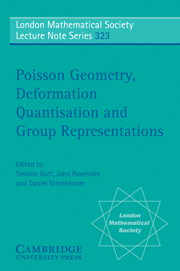Book contents
- Frontmatter
- Contents
- Preface
- Part One Poisson geometry and morita equivalence
- Part Two Formality and star products
- Part Three Lie groupoids, sheaves and cohomology
- 1 Introduction
- 2 Lie groupoids
- 3 Sheaves on Lie groupoids
- 4 Sheaf cohomology
- 5 Compactly supported cohomology
- Bibliography
- Part Four Geometric methods in representation theory
- Part Five Deformation theory: a powerful tool in physics modelling
- Index
1 - Introduction
Published online by Cambridge University Press: 04 August 2010
- Frontmatter
- Contents
- Preface
- Part One Poisson geometry and morita equivalence
- Part Two Formality and star products
- Part Three Lie groupoids, sheaves and cohomology
- 1 Introduction
- 2 Lie groupoids
- 3 Sheaves on Lie groupoids
- 4 Sheaf cohomology
- 5 Compactly supported cohomology
- Bibliography
- Part Four Geometric methods in representation theory
- Part Five Deformation theory: a powerful tool in physics modelling
- Index
Summary
The purpose of these lectures is to provide a quick introduction to a part of the theory of Lie groupoids, and to present some of their algebraic invariants, in particular the fundamental group and the equivariant sheaf cohomology.
In many different areas of mathematics, an increasingly important role is played by groupoids with some extra structure (smooth groupoids, groupoids in schemes, simplicial groupoids, symplectic groupoids, quantum groupoids, etc.). Many of the constructions and results to be presented here translate easily from one context to the other, and we hope that our introductory text will be of some use to students in different fields. For a detailed discussion of the role of groupoids in symplectic and Poisson geometry, we refer the reader to the contribution to this volume by Bursztyn and Weinstein [9], and the references cited there.
Groupoids often represent not-so-nice ‘quotients’ of nice structures, such as leaf spaces of foliations, stacks or orbifolds. Here the representing groupoids are usually only defined up to a weak ‘Morita’ equivalence, and it is this kind of equivalence which is playing a leading role in our lectures. The invariants we introduce (various cohomologies and the fundamental group) are all functorial and stable under this Morita equivalence. Thus it is natural to try and modify the category of Lie groupoids in such a way that the equivalences are turned into isomorphisms. It is known from various contexts (leaf spaces, toposes, stacks, cf. the introduction to Chapter 2) that it is possible to do so, and we give a precise treatment of it in the last two sections of Chapter 2.
- Type
- Chapter
- Information
- Publisher: Cambridge University PressPrint publication year: 2005

